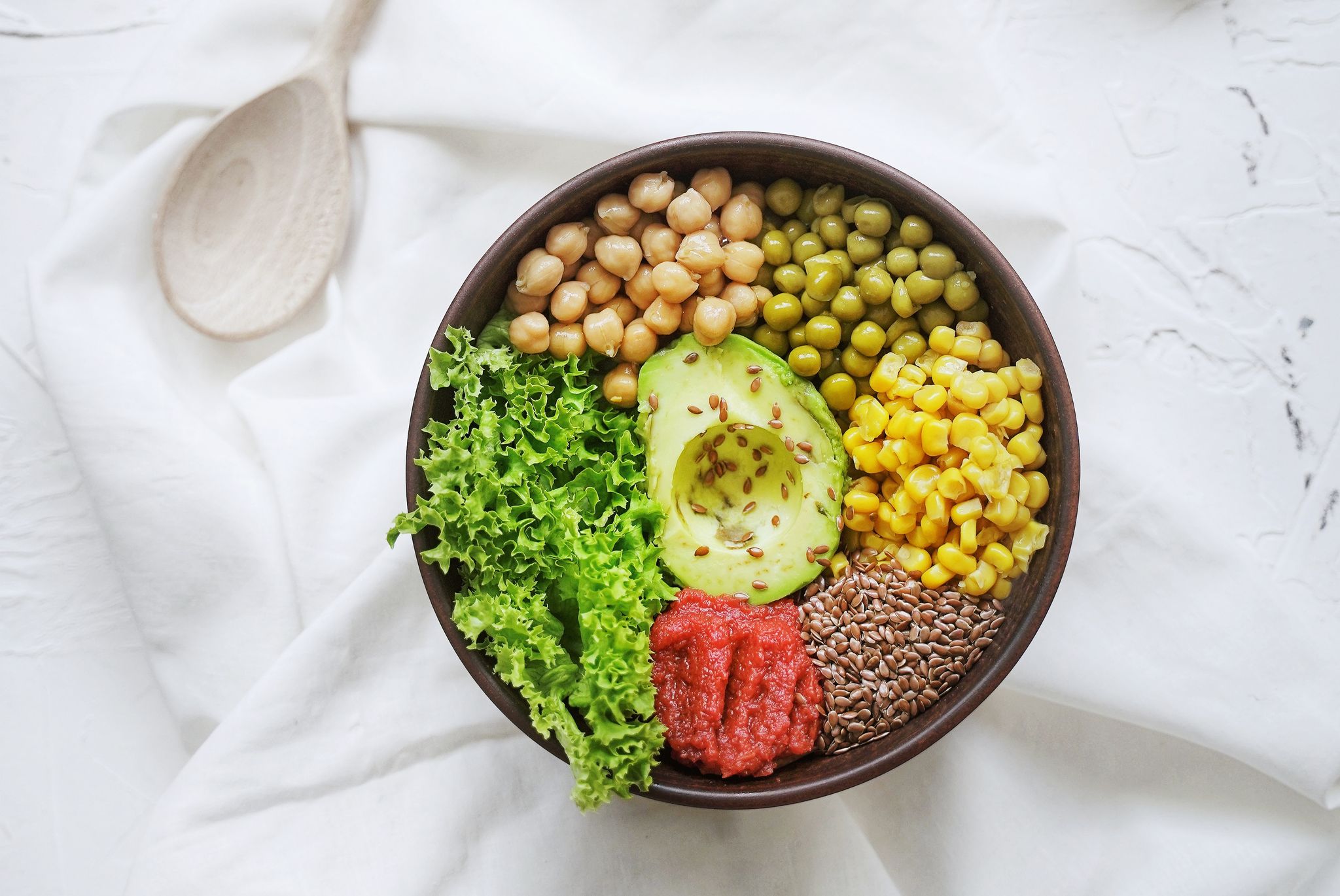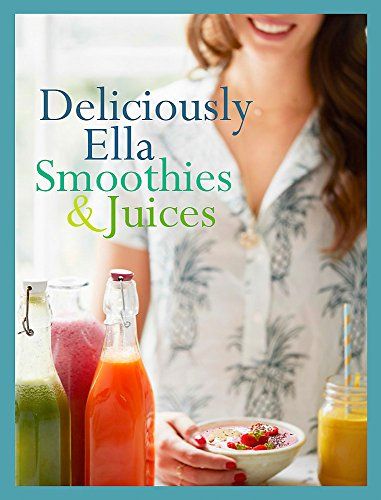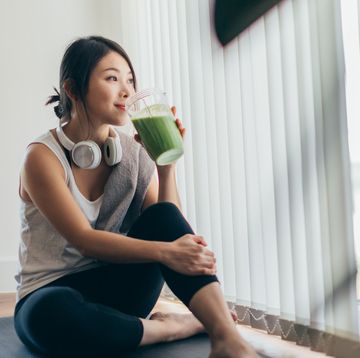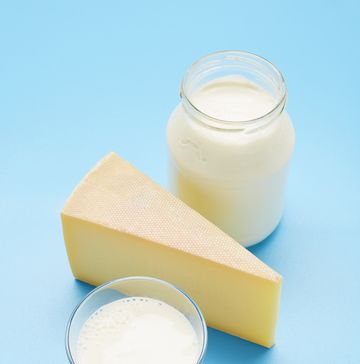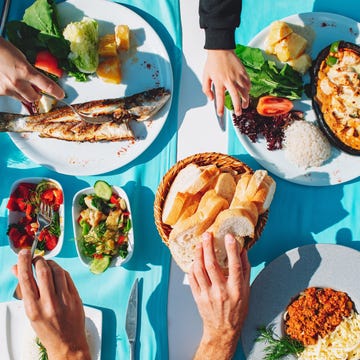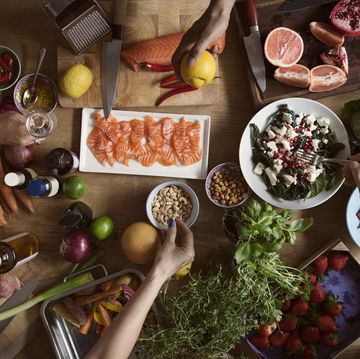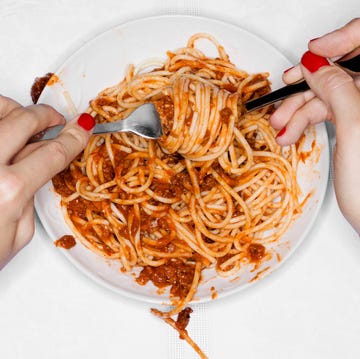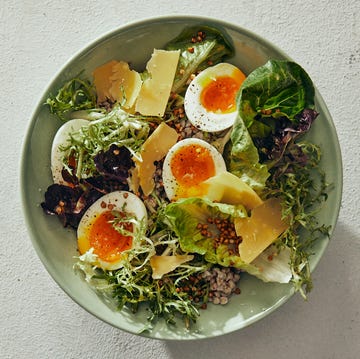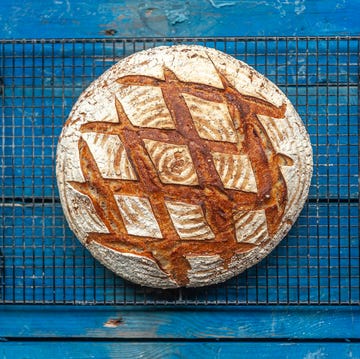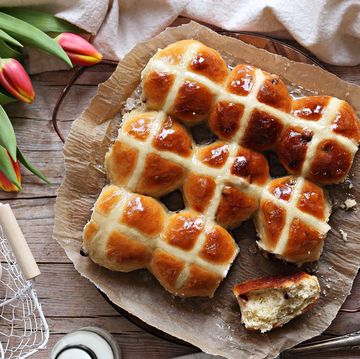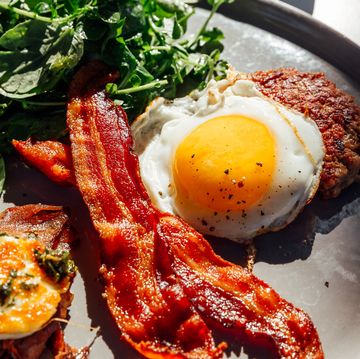Rather than loading up on Instagrammable shakes without really knowing what's in them or why they're beneficial, we've spoken to the experts about what to eat for all meals and snacks throughout an active week.
One thing to remember is, though you can maximise the effect of your exercise with your diet, it’s ‘dependent on the individual and the activity you are taking part in’, says Georgia Head, Nutritionist at Fresh Fitness Food.
‘Ideally, snacks and meals should contain a combination of protein, carbs and healthy fats.’
Robin Swinkels, another nutritionist at Fresh Fitness Food, has created a comprehensive weekly plan — varying intake depending on whether it’s a workout or rest day.
Rest days: 40% protein, 20% carbohydrate and 40% fat, on a 2000 kcal diet macros in grams would be 200 g protein, 100 g carbohydrate and 89 g fat.
Training days: 35% protein, 40% carbohydrate and 25% fat, on a 2000 kcal diet macros in grams would be 175 g protein, 200 g carbohydrate and 56 g fat.
Monday
TRAINING DAY
Breakfast: Yoghurt with raisins, cinnamon, apple and oats
Snack: Banana with peanut butter
Lunch: Grilled chicken with couscous/herb salad
Snack: Hummus with carrots, peppers and cucumber
Dinner: Cod with oven-roasted vegetables and sweet potato
Tuesday
Breakfast: Scrambled eggs with smoked salmon and cucumber/dill salad
Snack: Full fat yoghurt with blueberries and walnuts
Lunch: Italian Caprese salad with mozzarella, ham, basil and pine nuts
Snack: Rice cakes with banana and peanut butter
Dinner: Moroccan roasted lamb with steamed kale/spinach and olives
Wednesday
TRAINING DAY
Breakfast: Porridge with banana, mixed nuts and berries
Snack: Hummus on toast with smoked chicken and tomato
Lunch: Prawn and rice stuffed bell pepper
Snack: Almond butter dates
Dinner: Lean beef mince with whole-grain pasta and grilled vegetables
Thursday
TRAINING DAY
Breakfast: Fried egg on rye bread with rocket and sliced turkey
Snack: Mixed nuts with 2 squares dark chocolate
Lunch: Vegetarian tofu and lentil curry, with vegetables, coriander and peanuts
Snack: Salt and vinegar roasted chickpeas with almonds
Dinner: Chicken breast with steamed vegetables and whole-grain noodles
Friday
Breakfast: Kale, beetroot and feta frittata
Snack: Sweet and salty popcorn
Lunch: Satay pork chops with stir-fried Chinese cabbage, bok choy and baby corn
Snack: Rice cakes with avocado and smoked chicken
Dinner: Roasted salmon with fennel/parsley/red onion salad and macadamia nuts
Saturday
TRAINING DAY
Breakfast: Chia seed overnight pudding with pear and lemon
Snack: Mixed nuts with dried mango and dates
Lunch: Smoked mackerel on whole-grain toast with grilled vegetables and low-fat cream cheese
Snack: Cinnamon and honey roasted chickpeas with cashews
Dinner: Venison steak with brown rice and stir-fried vegetables
Sunday
Breakfast: Omelette with avocado, spinach and tomato
Snack: Rice cakes with cottage cheese and sundried tomato, salt and pepper
Lunch: Oven-roasted lemon chicken thigh with roasted Mediterranean vegetables and olives
Snack: Full fat yoghurt with strawberries and dark chocolate
Dinner: Grilled tuna with pan-fried tenderstem broccoli, asparagus and peppers, a summer salad and blue cheese
MACROS: You can calculate your actual daily calorie needs by calculating your macros.
Why you should eat differently on workout days
As well as — quelle surprise — upping protein on training days, Swinkels recommends increasing our carbohydrate and lowering our fat intake.
'It’s best to eat something higher in carbohydrates to provide adequate fuel, speed up recovery and improve protein synthesis, which prevents breakdown and leads to greater muscle gains’, says Miki Ferris, Personal Trainer at Equinox Kensington.
‘When we eat carbs, they are broken down into glucose, which is stored in our muscle cells as an energy source called glycogen that we can use when we workout. If the body isn’t properly fuelled before training, we may feel weaker or tired and more tempted to give up — or worse, risk injuring ourselves. I recommend a balance of complex carbs to provide sustained energy throughout your workout and help to keep blood sugar stable.’
Though it varies, based on what training you’re doing, says Swinkels: ‘Some types burn relatively more carbohydrate than others as our body uses different amounts depending on intensity. Training that involves sprints or quick, explosive movements — for example, team sports like tennis and netball — will burn more carbohydrate than yoga, low intensity cardio and weight lifting. Endurance exercise, such as running or cycling, will also eventually deplete the carbohydrate stores in our body so anyone doing this can also benefit from more on training days.’
What to eat 30 mins before a workout
It’s something we know from childhood; you can’t eat then exercise without feeling pretty nauseous. In fact, ‘if you are consuming enough across the course of a day, in regular intervals, a snack 30 minutes before your session is not always essential but can be used as a pick-me-up if needed’, says Head. ‘I would recommend going for something light and easy to digest, like a small piece of fruit.’
Ferris consumes a pre-workout meal 1-3 hours prior to a session or, if time-short, a nutritious pre-workout smoothie with fruit, nut butter and protein.
‘There is no ideal pre-and-post training guidelines for all’, says Head. 'It is always dependent on context, but pre-workout nutrition is vital to ensure you are adequately fuelled for the session ahead.’
If, for example, you plan to go for a 10km run or do a heavy weights session you should ensure you consume a meal or snack containing adequate carbs, which are the body's main source of energy, in the lead up to this session, as well as throughout the day.
Head recommends bananas, which are easy to pick up before a run or cycle and provide slow release energy; nuts and dried fruit, which are made up of glucose, so it’s easily burned by muscles as fuel during exercise; and apple and peanut butter, which is full of antioxidants and flavonoids.
Studies show flavonoid quercetin improved performance by increasing V02, the amount of oxygen the body can deliver to working muscles.
What to eat after exercising
‘Post-workout is all about recovery’, says Head. ‘Carbs to refuel your muscles and high-quality protein to initiate the repair of muscle tissue.’
She recommends homemade shakes, which are a great way to pack in plenty of digestible carbs and protein to help build and repair muscle but also these snacks:
- humous and crudités or rice cakes (plant-based protein and carbs)
- omelette with avocado, spinach and tomato (protein and fibre)
- chicken breast with steamed vegetables and wholegrain noodles(protein and slow release carbs)
But it varies with what you’re trying to achieve, explains Robin: ‘What matters most for fat loss is controlling your calories; simply making sure you burn more calories than you eat, so reduce them a little more on rest days. How you're making up the calories is much less important and there's not one right way of doing it’.
However, if you're aiming to gain muscle then sufficient protein and energy intake is required. ‘Although it's not impossible with a calorie deficit, building muscle tends to go best without one', continues Robin. 'Both sets of macros will provide sufficient protein for most but, as a rough guide, aim for about 1.8 g per kg bodyweight per day.’
What are the most common nutritional mistakes people make?
‘Demonising grains and carbs is a big one’, says Justin Jacobs, Nutrition Coach and Tier X Personal Training Manager.
‘As is crash dieting, which may seem effective initially but the swing in opposite direction is usually worse — whatever your goal is; be it fat loss or muscle gain.'
In fact, many of the pitfalls to watch out for fall under the faddy diet category, such as juice fasts, using supplements in lieu of real food and choosing the ‘healthy’ version, which is often processed to remove or add elements.
In short, aim to get ample nutrition from food first, in its truest form.
